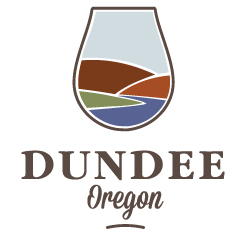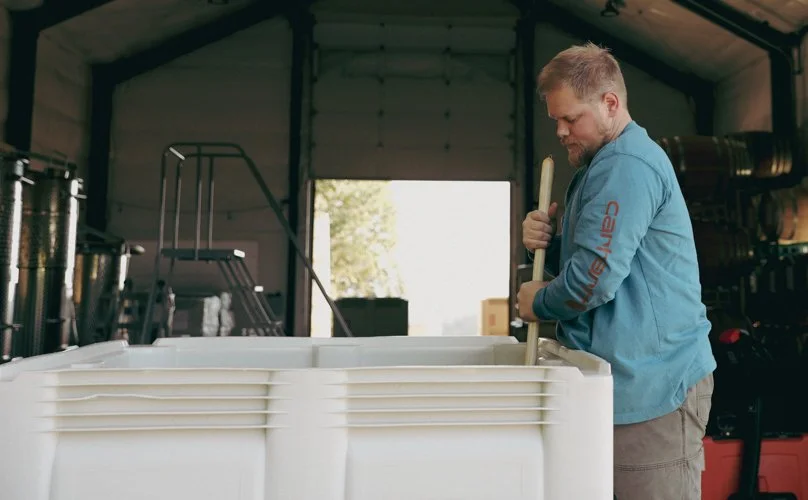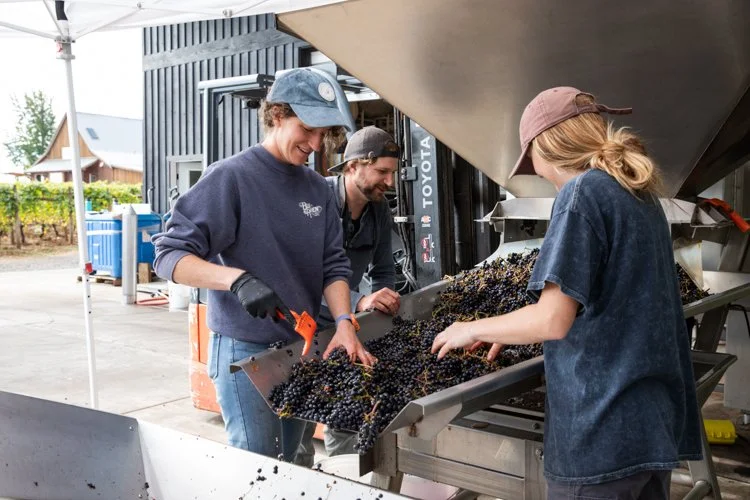Understanding Harvest in Oregon: The Unsung Heroes of the Season
Every year as Autumn creeps into Oregon wine country, the air begins to shift. Mornings have a crisp bite to them, the vines are heavy with fruit, and a subtle anticipation lurks as each vineyard waits for the right moment to begin their picks. Harvest is here and we have finally reached the most demanding, yet exhilarating time of year in the region.
For the average person, the fall season often consists of back to school, beautiful sunsets, and a gorgeous transition of the nature around them. If they are like us, this is also a period of going from sipping a crisp summer Chardonnay to pouring a smooth glass of Pinot Noir… Little do they know, behind every swirl and sip lies an untold story: the problem solving, long days, teamwork, and sheer grit it takes to turn grapes into the world-class wines Oregon is known for.
The Rhythm of Harvest
Harvest in Oregon typically runs from late August through late October, though timing can shift depending on the weather. Pinot Noir, the grape most synonymous with the Willamette Valley, is notoriously finicky. Winemakers and vineyard managers are constantly watching weather patterns, testing sugar and acidity levels, and tasting the fruit to make sure the physiology is developed enough to pick at the perfect moment.
The days are long. Picking crews often begin right at sunrise, ready with clippers and buckets as they quickly move row by row through the vines. Grapes must be harvested quickly to capture freshness and avoid overripening. From there, fruit is trucked to the winery, where it is often hand sorted, destemmed, and transferred into fermentation bins for its primary fermentation.
For the next 6–8 weeks, wineries are on the clock 24-7. Workers are constantly monitoring the ferments, checking their temperature, doing pump-overs, punch-downs, and cleaning equipment on repeat. This is the period when the foundation for each vintage is laid and safety becomes key in every move.
The Winemaker’s Role in Harvest
Winemakers are often celebrated for their passion and artistry. During harvest, the full spectrum of their role is revealed: They are part scientist, part artist, and all problem-solver.
second generation winemaker Jackson Holstein doing punchdowns at granville wines
During harvest, their days are dictated by the fruit. Depending on location, aspect, and elevation, one vineyard might ripen earlier than expected, another may lag behind. Weather can throw curveballs in planning. As we know, Fall in Oregon is lovely, but can mean rain, heat spike, even smoke in years where fires move into the Willamette Valley. Winemakers must have their formulas down, take on the responsibility for rapid decision making, and adjust their plan as many times as needed throughout the day and the season.
Winemakers don’t do it alone. They rely heavily on their team. The vineyard managers monitor ripeness and haul fruit, the cellar crews handle the physical work of moving fermentation bins, punch downs, and cleaning tanks, and the interns are eager to learn the ropes quickly and step in wherever help is needed.
The Vineyard and Cellar Teams: Harvest’s Backbone
As days get long for hardworking teams, winemakers need to be surrounded by people who they can trust. These crews are the backbone of harvest, often working 12–14 hour days in physically demanding roles.
In the vineyard, harvest workers carefully clip bunches with sharp shears, moving quickly yet gently to protect the fruit. This is repetitive, physical labor that requires endurance and precision. Without them, the fruit would never make it to the winery in the pristine condition required to craft Oregon’s elegant wines.
In the cellar, interns and full-time staff alike take on tasks that might not sound glamorous. Some of the jobs include scrubbing tanks, dragging hoses, shoveling grape skins from fermenters and these are absolutely essential to making the vintage a success. The work is exhausting, sticky, and often leaves one covered head-to-toe in grape juice, seeds, and oftentimes crawling creatures. Yet for many, it’s a rite of passage. Ask any winemaker about their early days (or current days), and you’ll hear endless stories of crazy mistakes, long nights, and the moments of pure joy when they finally tasted the finished product.
Why Does Harvest Matter?
Harvest is where the unique identity of each vintage is shaped. A colder year might produce wines with bright acidity and delicate aromatics. A warm harvest can bring rich, ripe fruit and lush textures. Aside from the uncontrollable logistics, the dedication, skill and passion of the people behind the scenes of this season are what make the Willamette Valley consistently shine in the world of craft wine.
For wine lovers, understanding harvest brings a new view to the experience of cracking open a bottle. It’s not just fermented juice… It's the culmination of thousands of small decisions from January to September in the vineyard, combined with all the work that the fruit sees post-pick and an unwavering commitment to doing what is right, even as the days get long and the conditions are rough. When you take a sip of your next Pinot Noir or Chardonnay, remember, you’re tasting a moment in time from a long season of work that wouldn’t be the same without the people who were a part of the journey.
Celebrate Harvest! Events That Aim to Bring this Season to Life
The Dundee Hills AVA wineries invite everyone to participate in the fun of the fall season. Join in on these events to hear the stories, connect with the workers on site, and make your own core memories with those involved in the magic of harvest:
Raising a Glass to the Unsung Harvest Heroes
As we move into fall, it’s worth appreciating that the wine we enjoy is only possible because of the countless dedicated hands during harvest. Winemakers may secure the names on the bottles we are drinking, but vineyard workers, cellar crews, and interns all contribute to the sips and stories inside.
The next time you pour from a bottle of Willamette Valley Pinot Noir, take a moment to imagine the sunrise over the vineyards as the workers run through the rows and clip the fruit, the hum of the sorting line, and the memories that carry winery crews through 14-hour days. That bottle is more than wine, it’s a testament to the people who give their all to make it possible.
















